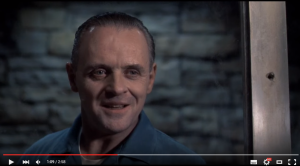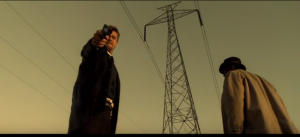For my advanced analysis I have decided to pick the scene from Silence of the Lambs Clarice Starling and Hannibal Lector first meet.
The establishing shot tracks around the corner to display Hannibal Lector standing in his cell communicating the full figure of the character, emphasizing his power in the process as he stands strong and confident. Further it displays his confined environment. Through this the viewers are able to get a good idea of the filmic space. This near-full shot is filmed from Clarice POV through two vertical steel beams creating strong vertical lines, leading the audience’s attention within this frame within a frame to Hannibal. From here the filmic space is clear and audience knows that the scene will continue to be a back and forth dialogue through the glass.

Often in drama two characters walk into a room, each wants something from the other bringing about the question of the scene ‘who gets what they want?’. This is one of those scenes. Through cinematography Demme creates a power struggle between the two characters. Firstly, they both look right into the lens examining each other This is displayed with close ups with a shallow depth of field and the characters in focus ensuring the viewers pay attention to their analytical stares. Furthermore this framing shows Hannibal and Clarice as equals, cutting back and forth on the same eye line. The two characters eye-lines are a major signifier of the power shift throughout the scene.


Although once Hannibal lands the first blow the camera moves over the shoulder as each characters builds up a defence. The OSS’ further set up the position of each person and further immerse the audience into the characters point of view. Once Hannibal tells Clarice to sit he gets his first close up signifying his power victory. From then one the camera always looks slightly down on Clarice and slightly up on Hannibal because he has the power in the scene. Demme cuts between close ups of the two as the dialouge progresses in which Hannibal looks the lens in the eye but Clarice looks off camera, putting the audience in her head. Jonathon Demme reenforce this by having the camera look where Clarice is looking with a combonation of pans and tilts, only to bring us back to Lector.
Clarices aim in this scene is to get Hannibal to look at a survey and every time she is to obvious about this the camera frames Hannibal with a stand-offish angle, displaying a certain degree of aggressiveness.

As Hannibal becomes more curious we move inside his point of view. So now Clarice looks the lens in the eye and Hannibal looks slightly off-screen. It also leads the audience to believe Clarice is winning. The close up of the survey emphasises its important. Once Lecture becomes more aggressive and serious the camera dollys closer towards him and frames him perfectly before cutting to wider shot looking down Clarice making her look powerless and off-balance.
From then on the camera captures both characters looking slightly off-screen signifying they aren’t looking eye to eye anymore. Soon Hannibal is framed in a mid shot as he turns his back and walks away from Clarice signaling he isn’t interested in the conversation anymore. This is mirrored in the next shot when Clarice does the same, walking directly away from the camera. The medium long shot is framed so the audience can see the detail in the old ghastly looking prison. This cuts to a profile shot of her detailing the intensity on her face. She turns to the right slightly and the camera cuts to take her point of view, looking at Migs through the bars. The viewer knows its her point of view because she turns her head and then it suddenly cuts. After Mig’s disgusting act the camera quickly pushes towards a prisoners through the bars face as he yells, creating chaos. Demme cuts between the various prisoners and midshots of Clarice being frantic, displaying intense fear for the first time. The viewer is then presented with the first two shot of the entire scene. With both characters together in the same frame, the camera looks up and pushes forward displaying their faces close together, divided only by glass. Through doing this, Demmes’ establishes an on-going relationship between the two characters for the rest of the film.

The découpage of this scene is incredible to me. The shots have been peiced together perfectly to present a back and forth power struggle which is primarily expressed through eyelines, camera angle and position. This is supported by strong performances, good low key lighting creating eery shadows and mostly silent soundtrack focusing the vewiers on the words being exchanged.
By writing this scene analysis I’ve started to think more about the importance of eyelines and camera angles in terms of establishing filmic space and representing the power in which a character may have over another.
Over and out,
Luke Egan




